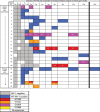Transmission of nevirapine-resistant HIV type 1 via breast milk to infants after single-dose nevirapine in Beira, Mozambique
- PMID: 24596282
- PMCID: PMC4133577
- DOI: 10.1093/infdis/jiu130
Transmission of nevirapine-resistant HIV type 1 via breast milk to infants after single-dose nevirapine in Beira, Mozambique
Abstract
Acquisition of nevirapine (NVP)-resistant human immunodeficiency virus type 1 (HIV-1) by breast-feeding infants after receipt of single-dose NVP to prevent mother-to-child transmission is not well defined. A prospective observational study of 307 infants evaluated the rate of breast milk transmission of NVP-resistant HIV and the concentrations of mutants over time. NVP resistance was detected in 9 of 24 infants (37.5%; 95% confidence interval, 18.8%-59.4%) infected via breast milk. Eight had a pure mutant HIV population at the time infection was first detected, and majority mutant populations persisted in all 6 infants with follow-up specimens. Infection of breast-feeding infants with NVP-resistant HIV resulted in mutants persisting as the dominant virus, which may indefinitely compromise treatment with NVP-based antiretroviral regimens.
Keywords: HIV-1; drug-resistance; mother-to-child transmission; nevirapine; zidovudine.
© The Author 2014. Published by Oxford University Press on behalf of the Infectious Diseases Society of America. All rights reserved. For Permissions, please e-mail: journals.permissions@oup.com.
Figures

Similar articles
-
Nevirapine resistance and breast-milk HIV transmission: effects of single and extended-dose nevirapine prophylaxis in subtype C HIV-infected infants.PLoS One. 2009;4(1):e4096. doi: 10.1371/journal.pone.0004096. Epub 2009 Jan 1. PLoS One. 2009. PMID: 19119321 Free PMC article. Clinical Trial.
-
Clonal amplification and maternal-infant transmission of nevirapine-resistant HIV-1 variants in breast milk following single-dose nevirapine prophylaxis.Retrovirology. 2013 Aug 14;10:88. doi: 10.1186/1742-4690-10-88. Retrovirology. 2013. PMID: 23941304 Free PMC article.
-
Slower clearance of nevirapine resistant virus in infants failing extended nevirapine prophylaxis for prevention of mother-to-child HIV transmission.AIDS Res Hum Retroviruses. 2011 Aug;27(8):823-9. doi: 10.1089/aid.2010.0346. Epub 2011 Feb 25. AIDS Res Hum Retroviruses. 2011. PMID: 21241214 Free PMC article. Clinical Trial.
-
Use of single-dose nevirapine for the prevention of mother-to-child transmission of HIV-1: does development of resistance matter?Am J Obstet Gynecol. 2007 Sep;197(3 Suppl):S56-63. doi: 10.1016/j.ajog.2007.02.031. Am J Obstet Gynecol. 2007. PMID: 17825651 Review.
-
[Drug resistance of HIV-1 as a result of using nevirapine for chemoprophylaxis of vertical viral transmission from HIV-infected mother to infant].Vopr Virusol. 2009 Jan-Feb;54(1):45-8. Vopr Virusol. 2009. PMID: 19253732 Review. Russian.
Cited by
-
HIV-1 Antiretroviral Drug Resistance in Mozambique: A Systematic Review and Meta-Analysis.Viruses. 2024 Nov 21;16(12):1808. doi: 10.3390/v16121808. Viruses. 2024. PMID: 39772119 Free PMC article.
-
Breast milk pharmacokinetics of efavirenz and breastfed infants' exposure in genetically defined subgroups of mother-infant pairs: an observational study.Clin Infect Dis. 2015 Aug 1;61(3):453-63. doi: 10.1093/cid/civ317. Epub 2015 Apr 16. Clin Infect Dis. 2015. PMID: 25882300 Free PMC article.
-
Persistence of HIV drug resistance among South African children given nevirapine to prevent mother-to-child-transmission.AIDS. 2017 May 15;31(8):1143-1148. doi: 10.1097/QAD.0000000000001446. AIDS. 2017. PMID: 28301421 Free PMC article.
-
Nevirapine hair and plasma concentrations and HIV-1 viral suppression among HIV infected ante-partum and post-partum women attended in a mother and child prevention program in Maputo city, Mozambique.PLoS One. 2022 Feb 10;17(2):e0261522. doi: 10.1371/journal.pone.0261522. eCollection 2022. PLoS One. 2022. PMID: 35143515 Free PMC article.
-
HIV drug resistance patterns in pregnant women using next generation sequence in Mozambique.PLoS One. 2018 May 9;13(5):e0196451. doi: 10.1371/journal.pone.0196451. eCollection 2018. PLoS One. 2018. PMID: 29742132 Free PMC article.
References
-
- UNAIDS. Geneva: Joint United Nations Programme on HIV/AIDS; 2012. Global Report, UNAIDS Report on the Global AIDS Epidemic: 2012.
-
- WHO. Geneva: World Health Organization; 2013. Consolidated guidelines on the use of antiretroviral drugs for treating and preventing HIV infection; recommendations for a public health approach. - PubMed
-
- Little SJ, Holte S, Routy JP, et al. Antiretroviral-drug resistance among patients recently infected with HIV. N Engl J Med. 2002;347:385–94. - PubMed
Publication types
MeSH terms
Substances
Grants and funding
LinkOut - more resources
Full Text Sources
Other Literature Sources
Medical
Molecular Biology Databases

